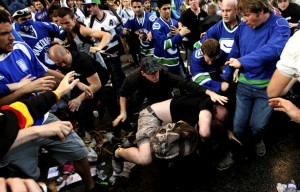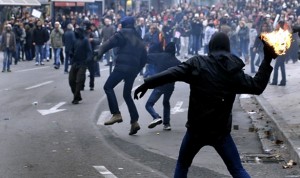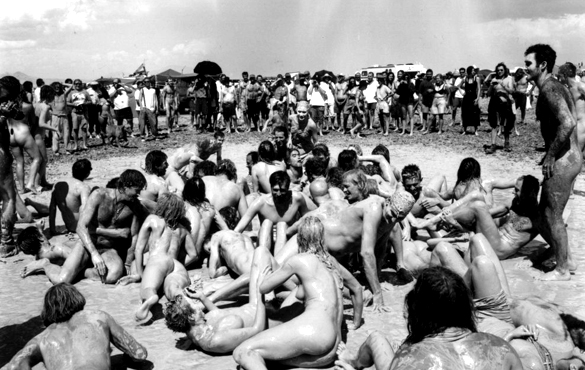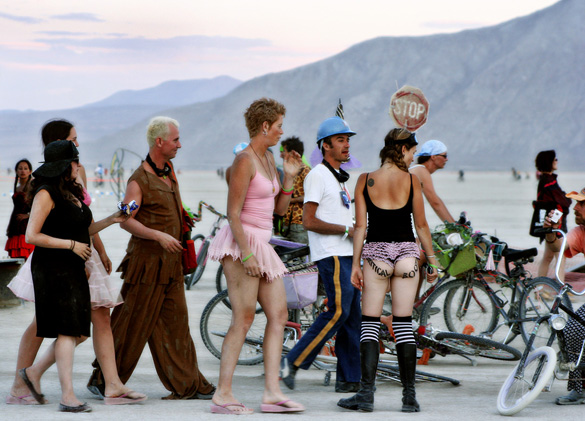In my last article, I questioned the value of the Burning Man festival’s Dionysian tendencies, its egregious sponsorship of wastefulness that juts out particularly in light of its stated values, e.g., “Leaving No Trace.” I still possess no doubt concerning the hypocrisy of the event. But thinking further on the fiery madness, I saw a connection to a notion lurking within Chelsea Hicks’ post on warrior culture’s infiltration of sports, an essential characteristic of every sporting event: the mob mentality.
A week after I posted the original article, I spoke with a Burner about his experience at the festival. He commented upon the hoards of attendees who stripped down to nothing, naked as in birth, dancing about in the desert glow all together in an act of unabashed freedom.
As I previously stated, 40,000 people regularly attend Burning Man. In light of the sizeable population of people participating, it doesn’t seem so difficult to comprehend the ease of joining in the nudity, or even, in the burning of the Trojan Horse. You would undoubtedly be castigated for not taking off your clothes rather than vice versa. Refuse to strip and be scorned. Refuse to burn and be deemed “Other.” When there are 39,999 other people approving the burning of the Horse, how can one possibly raise her discordant voice?
“Madness is rare in individuals—but in groups, parties, nations, and ages it is the rule,” said Nietzsche in Beyond Good and Evil. Mob mentality or herd behavior takes hold when a person experiences deindividuation, the loss of both self- awareness and a sense of self-identity that materializes when one individual becomes one of many[i]. Emotion contagion ensues, the permeation of a feeling, either positive or negative, through a crowd[ii] Generally-considered absurdities become acceptable when people join together in unity, in brotherhood, to commit these acts. A beer-belly painted maroon is normalized via public football games in which thousands of others have transgressed normal standards of decorum and self-adornment before. Setting a car ablaze because your beloved Canucks lost the Stanley Cup is perfectly permissible when your fellow man is assisting another in flipping over a truck, smashing the windows of businesses, looting, throwing beer bottles, and stomping atop police vehicles. Violence, indecency, lunacy, idiocy become the status quo within a large mob.
awareness and a sense of self-identity that materializes when one individual becomes one of many[i]. Emotion contagion ensues, the permeation of a feeling, either positive or negative, through a crowd[ii] Generally-considered absurdities become acceptable when people join together in unity, in brotherhood, to commit these acts. A beer-belly painted maroon is normalized via public football games in which thousands of others have transgressed normal standards of decorum and self-adornment before. Setting a car ablaze because your beloved Canucks lost the Stanley Cup is perfectly permissible when your fellow man is assisting another in flipping over a truck, smashing the windows of businesses, looting, throwing beer bottles, and stomping atop police vehicles. Violence, indecency, lunacy, idiocy become the status quo within a large mob.
The influence of the herd can have drastic and devastating consequences. The larger the crowd, the greater likelihood that the bystander effect will kick into action, a phenomenon that leads to a diffusion of responsibility, a decreased proclivity to step in and put a stop to the pandemonium. The instance of Kitty Genovese, whose cries for help faded into the New York City air unheeded after being stabbed twice in the back, epitomizes the phenomenon. During the Nuremburg trials that took place between 1945 and 1949, former Nazi officials such as Wilhelm Keitel, the Chief of Staff of the High Command under Hitler, justified their participation in the bureaucratic extermination of six million Jews by arguing that they were simply fulfilling their duties as soldiers by “just following orders.”[iii]
Of course, mob mentality does not always connote a negative phenomenon. Converging in a public place to dance to “Thriller” in unison is an innocuous and entertaining spectacle. Screaming the lyrics of that song at that concert of that band that you love is much less embarrassing (for some) when thousands of others are screaming, pitchedly, along. Temporarily allowing awareness to fade out can be rejuvenating, cathartic, a washing out of society’s expectations and a rushing in of what we like to consider our True, Unadorned Selves.
And ultimately, that seems to be the goal of Burning Man and other mass group activities. Participation in a larger experience, the construction of said experience via a unified effort, is humbling, allowing one to forget about Me Me My in this increasingly egocentric western culture for the brief coming together of myriad strangers. It becomes more about the group than the individual. This is, of course, a positive consequence of being a part of the crowd.
Yet at the same time, losing awareness of the self can lead to delusion on a grandiose scale, a suffocating ignorance. The Holocaust is an extreme example of mob mentality in its most heinous form. But seemingly harmless, “fun” experiences, e.g. painting your face the color of your favorite football team, not wearing white after labor day, is tantamount to shutting off one’s reasoning capabilities, allowing some other guy to make decisions for you. Pride and Unity can become synonymous with Submission and Stark Homogeneity. It is not hard to say that the Canadian sports-fans were not thinking things through when they wreaked havoc and destruction upon their own city of Vancouver. And clearly, releasing noxious carbon monoxide, hydrocarbons, and nitrogen oxides into the air by burning a gigantic wooden horse is also nonsensical. Is team cohesion really worth it?
Unity can become synonymous with Submission and Stark Homogeneity. It is not hard to say that the Canadian sports-fans were not thinking things through when they wreaked havoc and destruction upon their own city of Vancouver. And clearly, releasing noxious carbon monoxide, hydrocarbons, and nitrogen oxides into the air by burning a gigantic wooden horse is also nonsensical. Is team cohesion really worth it?


